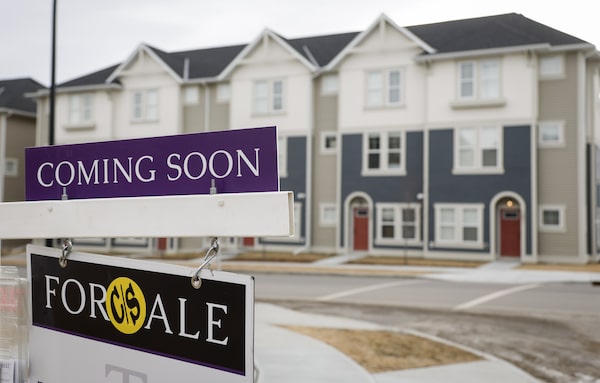
Houses for sale in a new subdivision in Airdrie, Alta., on Jan. 28.Jeff McIntosh/The Canadian Press
No offence to the build-more-houses crowd, but the quickest path to more affordable housing is lower prices.
Correction: Much lower prices. As mortgage rates rise, affordability can worsen even as prices fall.
The real estate boom of the past two years created an affordability crisis for young adults who aspire to own a house. With housing markets on the decline in spring 2022, it’s an ideal time to look into the near-term feasibility of houses becoming more affordable.
The wildcard here is mortgage rates. They’re the big decider now in affordability, not prices.
Several national mortgage brokerage companies offered a 4.19-per-cent five-year fixed rate mortgage as of early this week, roughly double the level of last fall. We’ve seen high-velocity mortgage rate changes before in recent decades, but on the down side. Further rate increases are possible.
House prices are on the decline, but only just recently. The average national resale price in April was up 7.4 per cent to $746,146 on a year-over-year basis, but down 6.2 per cent from March. In Toronto, the average April price of $1,254,436 was up 15 per cent year over year and down 3.5 per cent from March.
To understand the interplay of changes in prices and rates, consider a home bought in February at the national average price of $816,720. Mortgage rates were cheaper back then, so let’s plug in a five-year fixed rate at 2.5 per cent that gives us a monthly payment of $3,395 based on a 10-per-cent down payment and 25-year amortization.
Now, for a comparison using today’s 4.19-per-cent five-year fixed mortgage rate and the April average price of $746,146. This combination of lower prices and higher borrowing costs would give you a monthly payment of $3,714, which means an extra $319 a month compared to February.
Imagine that mortgage rates plateau for a while, but prices fall another 10 per cent or so in the months ahead to $671,500. With the same 4.19-per-cent mortgage rate offered today, the monthly payment works out to $3,342. We’re now $53 a month cheaper than February, which is a start on improving affordability.
Upward pressure on mortgage rates has eased for now, but further increases could happen in the months ahead. A rise to 4.5 per cent for a five-year fixed rate mortgage would push up payments on a house priced at $671,500 to $3,449. Goodbye, affordability gains.
Might further price declines help? The experience of the past 40 years in real estate suggests you not get your hopes up.
There have been seven annual price drops on an average national basis since 1981, data from the Canadian Real Estate Association show. The range of declines was 0.5 per cent to almost 5 per cent, with an average of 2.7 per cent. As older boomers and seniors will remember, there was a monster decline in Toronto in the 1990s with a peak to valley annual price drop of 23 per cent over six years.
The Toronto example seems more relevant today, given that it resulted from an intense level of speculation in residential real estate. The build-more-houses people argue we have a supply problem in housing today, but demand from people buying homes as an investment is a major cause of today’s unaffordability problem.
Rising rates hurt the investment appeal of owning a house to flip or rent out. If investors step back from the market, then there’s less competition to buy homes, which will reduce upward pressure on prices. This may explain why housing is a lot calmer now, with fewer buyers competing for homes on sale.
Relief from bidding wars in itself is a victory for affordability in that you have predictability on the price of getting a deal done. But real progress on affordability will only come from lower down payments and monthly mortgage costs.
Down payment costs are falling – the amount needed for a 10-per-cent down payment fell more than $7,000 from February to April based on national average resale prices. But monthly mortgage payments are higher.
Building more houses won’t get those payments down in the near term, which means you’ll need a serious price decline that more than offsets mortgage rate increases. Average prices are up more than 50 per cent in the past two years, so it’s not out of the question.
Are you a young Canadian with money on your mind? To set yourself up for success and steer clear of costly mistakes, listen to our award-winning Stress Test podcast.
 Rob Carrick
Rob Carrick